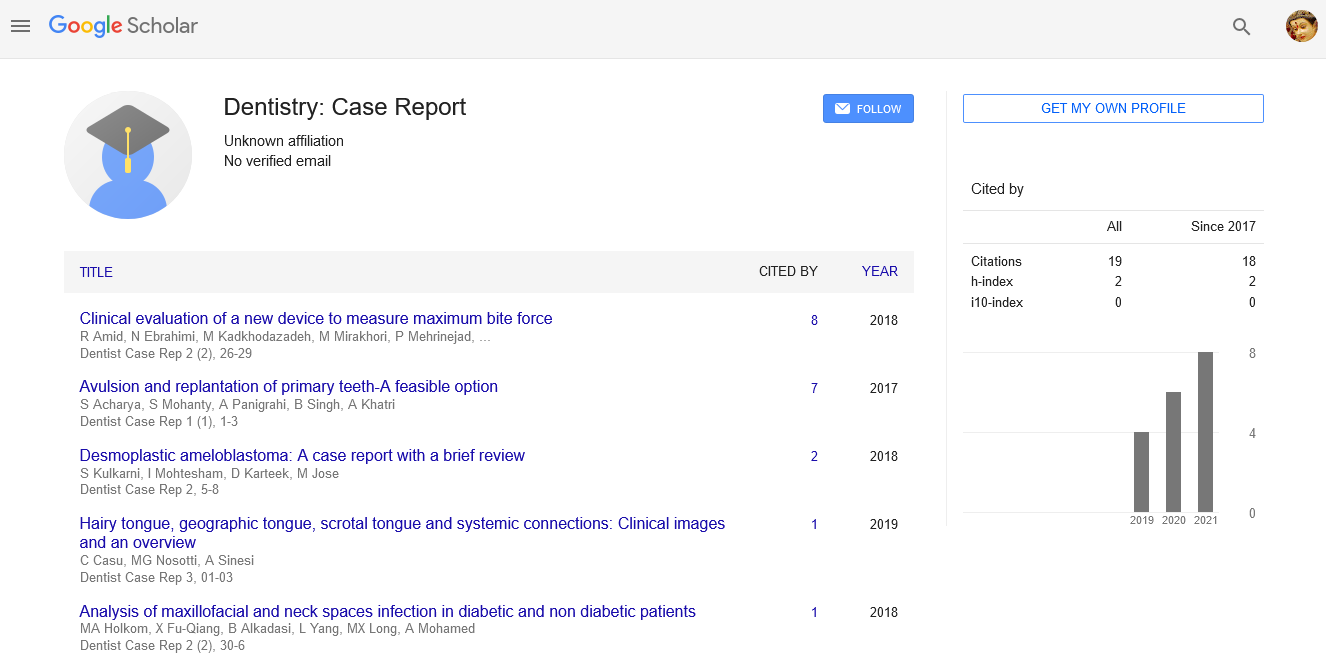Short Dental Implants: An Overview
Received: 30-Jan-2018 Accepted Date: Jan 31, 2018; Published: 17-Feb-2018
Citation: de Chaves e Mello Dias ECL. Short Dental Implants: An Overview. J Dent Oral Res 2018;1(1):4
This open-access article is distributed under the terms of the Creative Commons Attribution Non-Commercial License (CC BY-NC) (http://creativecommons.org/licenses/by-nc/4.0/), which permits reuse, distribution and reproduction of the article, provided that the original work is properly cited and the reuse is restricted to noncommercial purposes. For commercial reuse, contact reprints@pulsus.com
Editorial
Short dental implants (<10 mm) were initially viewed with suspicion, since studies from the 1980s and early 1990s indicated a lower success rate, with up to three times greater losses compared to the longer ones [1]. This has led many professionals to stop considering short implants as a treatment option. However, if we observe these studies carefully we can verify that they used mostly machined surface implants, besides a surgical technique that was not adapted for the short implants. Another factor to consider in these studies is that short implants were installed where it was not possible to install longer implants. This led to the development of several surgical techniques to increase the available bone in height for the installation of longer implants such as lateralization of the inferior alveolar nerve, vertical osteogenic distraction, guided bone regeneration, among others.
From the end of the 1990s there was a change from short implants. New implant designs and the development of rough and bioactive surfaces, as well as a better understanding of the factors related to biomechanics, resulted in short implants having a success rate similar to longer implants.
Today, we are increasingly researching procedures to simplify and shorten treatment time. While bone reconstruction techniques are time-consuming, costly and have considerable morbidities and may increase this time [2], short implants present themselves with the aim of simplifying and reducing the treatment time, as well as avoiding that more complicated surgeries need to be performed, increasing therefore patient acceptance.
Some advantages can be attributed to short implants when compared to reconstructive techniques. While vertical bone augmentation techniques are complex and require extensive training of surgeons, surgery for the installation of short implants is quite similar to that used for the installation of conventional implants, to which the implant dentist is more familiarized. However, some care is needed. Decreasing the number of rotations in the motor during preparation of the implant bed can lead to lower bone heating and consequently decrease the risk of traumatic bone loss. Another advantage of the short implants is the reduction of the danger of injury to the noble anatomical areas such as the inferior alveolar nerve and the maxillary sinus membrane, since more complex surgeries are avoided. The need for grafting procedures is also diminished in treatments with short implants, although sometimes a grafting technique is necessary [3].
Current scientific literature has shown success rates of short implants similar to the ones attributed to longer implants installed in areas of vertical bone augmentation and even similar to those installed in native bone. This makes short implants a reliable treatment option, with less trauma and better treatment cost [4].
Considering that Dentistry has become less and less invasive, short implants should be part of the therapeutic arsenal of professionals involved in Implant Dentistry.
REFERENCES
- van Steenberghe D, Lekholm U, Bolender C, et al. The applicability of osseointegrated oral implants in the rehabilitation of partial edentulism. A prospective multicenter study on 558 fixtures. Int J Oral Maxillofac Implants 1990;5:272-281.
- Tonetti MS, Hämmerle CHF. Advances in bone augmentation to enable dental implant placement: Consensus report of the Sixth European Workshop on Periodontology. J Clin Periodontol 2008;35:168-172.
- Thoma DS, Zeltner M, Hüsler J, et al. EAO Supplement Working Group 4- EAO CC 2015 Short implants versus sinus lifting with longer implants to restore the posterior maxilla: a systematic review. Clin Oral Implant Res 2015;26:154-169.
- Pieri F, Forlivesi C, Caselli E, et al. Short implants (6 mm) vs. vertical bone augmentation and standard-length implants (≥9mm) in atrophic posterior mandibles: a 5-year retrospective study. Int J Oral Maxillofac Surg. 2017:46:1607-1614.





